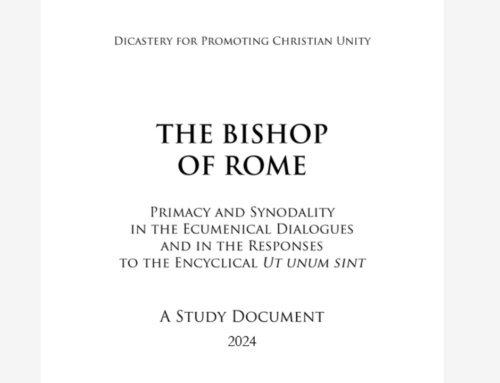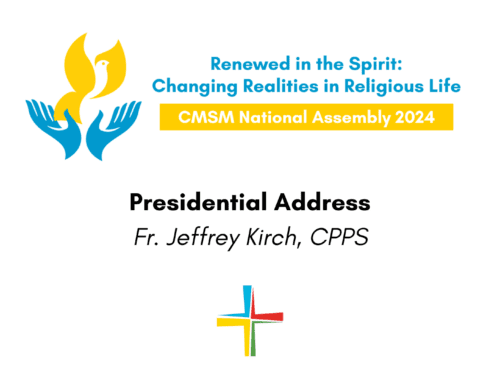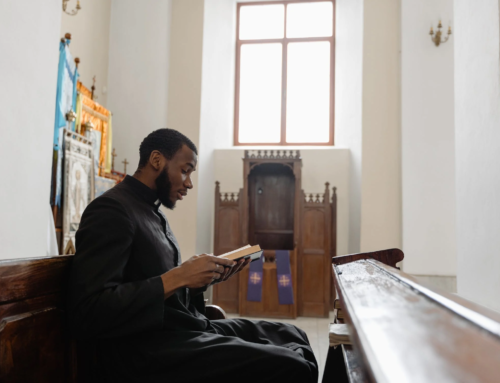Br. Sam Amos, FMS examines the meaning of science in the life of his high school students, arguing that their very interest in science and respect for its authority is an opportunity for theology teachers and ministers. The questions science and technology raise in the 21st century require answers that go beyond the empirical; science and technology only become threatening when there is a refusal to engage with students’ questions and interest in science. Click here to download a copy of this essay. This essay is on the same theme of our first special issue of the print journal – faith, reason, and religious life – due out in early November.
As consecrated religious, we are called by the Second Vatican Council to be aware of the social conditions of our own time to be better able to serve the needs of the Church.[1] Two major social conditions of our own day are the dominance of the physical sciences, and secularization and youth disengagement from organized religion. The former is often thought of as a cause of the latter, but in this essay I will argue that the advancement of science actually provides an important opportunity to help young people explore their own religious faith.
For the past two years, I have had a privileged perspective on the way young people think about science and religion. My school offers a senior elective course called Faith, Science, and Reason, which explores the intersection of religion and science, and is co-taught by a physics teacher from the school’s science department and me. My experience in this class is that far from being indifferent to religion, the young people I taught were very interested in it, not in spite of, but because of their confidence in science. Science gives rise to technology that is daily reshaping the world, and this in turn raises questions of value and meaning to which the physical sciences do not speak. For these questions, my students, who expect to see the world change drastically within their lifetimes, turn to religion, as well as other fields like philosophy, ethics, and political science.
The Class
Faith, Science, and Reason is a largely discussion-based course. It was originally designed based on the Science and Religion Seminars offered through the University of Notre Dame’s McGrath Institute for Church Life by my current co-teacher and another religion teacher at Marist. The class starts out by reviewing the necessary basics for both fields: the scientific method for science, and basic Catholic beliefs about revelation, tradition, and biblical interpretation for religion. Later, the students learn about and discuss the history of the relationship between faith and science.
Eventually, we move on to the future. It is here that the students have the deepest conversations, and produce some of their best writing, when we discuss emerging issues in science and technology: artificial intelligence, automation and robotics, virtual reality, cybernetic augmentation of the human body, genetic engineering, climate change, and space colonization. They are deeply interested in and passionate about these topics, not as fanciful science fiction concepts, but as current realities that will reshape the world throughout their lifetimes. These are not abstract issues, but things they will likely have to deal with and make personal decisions about at some point during their lives.
Their World
This is the world in which my students are coming of age: The genetic modification of plants and animals began well before they were born. They have never known a time when food and pharmaceuticals derived from genetically modified plants, animals, and bacteria were not commercially available. In 2008 (when my students were in kindergarten) the discovery of CRISPR-Cas9 made gene editing exponentially cheaper and easier.[2] People can now order DIY CRISPR kits to genetically modify bacteria off of the Internet for less than $200.[3] In the fall of 2018 (when my students were sophomores) the first genetically modified human beings were born in China: twin girls whose genomes had been edited through CRISPR at the embryonic stage to give them HIV-resistance.[4]
Things are developing just as rapidly in the field of computer science. In 2020, the San Francisco-based OpenAI lab launched GPT-3, an AI language model which can produce written texts that can be mistaken for those written by a human being.[5] In January of this year, K. Allado-McDowell published Pharmako-AI, a book of essays he and GPT-3 “co-authored” together.[6]
Founded in 2002 (the year before my students were born), Elon Musk’s SpaceX Corporation has been aggressively lowering the cost of launching satellites and astronauts into space through the use of their reusable Falcon 9 rockets. They are using these same rockets to launch their Starlink communication satellite constellation for the purpose of providing satellite Internet access across the globe. The company is currently developing Starship, a reusable rocket system designed for interplanetary flight. SpaceX’s stated goal is to enable the colonization of Mars.[7]
Humanity may well need another planet. Released in May, 2019 (when my students were sophomores), the United Nations’ Global Assessment Report on Biodiversity and Ecosystem Services details the serious negative impact human overconsumption has had on the natural environment. The report estimates that one in four plant and animal species are now in danger of extinction.[8] Every year, roughly 300 million metric tons of toxic sludge, solvents, and heavy metals enter the water cycle from industrial facilities.[9] The UN Intergovernmental Panel on Climate Change’s Fifth Assessment Report, published in 2014 (when my students were in the sixth grade) reports that without policies to mitigate human-caused climate change, global temperatures in 2100 will be up to 5°C higher relative to pre-industrial norms, which will have a profound, negative impact on the natural environment and humanity’s ability to survive on the planet.[10]
These are the questions my students are asking themselves: “How would I feel about having a genetically engineered child? That could be an option by the time I’m ready to start a family. Will I have a decent, steady job then, or will so much of the economy be automated by then that I will have a hard time finding a good career? If I do have a career, how will I feel about working alongside AI’s? That will probably be part of my professional life. It will probably be part of my personal life too. Would I want a personal AI assistant helping me to manage my affairs? If there is immersive, easily accessible virtual reality, how much of my time would I want to spend in it? Could I get lost in it, get addicted to it? As I age, would I want cybernetic augmentations in my body to help maintain my quality of life? How safe and stable will the world even be when I’m older because of climate change and the deterioration of the environment?”
The idea that science undermines the need for religion entirely misses the point of what is happening in the world. Science is moving forward at a breakneck speed, providing us with ever more information about the physical universe. This gives rise to rapid technological development, which in turn creates profound social, economic, and political changes. These changes raise questions of value, identity, obligation, and meaning to which the physical sciences do not speak. Behind my students’ specific and concrete questions about their future lie much broader, more abstract ones: What does it mean to be human? What, if anything, do we not have the right to change about ourselves? What is the value of my life and what I do with it? What are my obligations to my fellow human beings? What are my obligations to all the other living things with which I share the planet? What is our future as a species? What do I owe to future generations not yet born?
Their Faith
American culture is going through a period of secularization. In 2017, the Going, Going, Gone study commissioned by St. Mary’s Press estimated that roughly one in eight young people between the ages of 18 and 25 were former Catholics.[11] Obviously, the causes of youth disaffiliation are nuanced and complex, but I would posit that one of the causes is that when young people are taught the Faith, they are not shown how it might offer answers and guidance to the existential questions they are facing.
In class, we discuss ways in which our Catholic Faith might guide us as we face a changing world. As an example, one touchstone that we return to again and again is the First Creation story in Genesis. We, of course, read this not as a literalistic account of the formation of the universe, but as a narrative description of the most important facts of life: God’s loving providence, the essential goodness of the physical universe and the natural world, and the basic dignity and value of human beings, made in the image and likeness of God. The students find these truths helpful as starting points when thinking about and discussing the future that lies before them.
Here I need to offer two caveats: The first is that while they do want to talk about religion, they do not want to talk about only religion. They also want to explore their questions through the lenses of philosophy, political science, and psychology, and our class discussions often drift into these fields. This, I think, is entirely healthy and appropriate. The second caveat is that while my students want to know the teachings of the Church on different subjects, they do not necessarily like or agree with certain teachings. As in any class that deals with anything worthwhile, my co-teacher and I have to be prepared for difficult but respectful conversations.
Conclusion
If those of us who work in catechesis and religious education ever feel that science is a threat to religious belief, we are badly misreading the situation, and, what is worse, not meeting a pressing need our students have. Young people rightly respect and value science for revealing so much about the physical universe and empowering humanity through technological advancement. This very technological advancement gives rise to social change that raises spiritual and existential questions of value and meaning that young people want to explore through the lens of religion. If religious educators ignore science or see it as a threat, they are blinding themselves to the very questions that our students most want answered. If we fail to show young people the tools and resources their faith offers them for dealing with the issues they will face later in life, we are failing them terribly, and we are falling short of our own vocation as religious by not being aware of the needs of the times.
As a summative assessment, at the end of this year’s Faith, Science, and Reason course, my co-teacher and I had our students write research papers on an emerging issue in science and technology and analyze it from an ethical and religious lens. They wrote thoughtful and nuanced papers exploring, among other things, genetic modification of human beings, the nature of artificial intelligence, and the colonization of space. My co-teacher and I were proud of the way they were able to think deeply and critically about these topics in light of their values and their faith. As one student wrote on her class survey at the end of the year, “I can now examine [these issues] through the multi-faceted lens of faith, science, and logical reasoning.”
[1] Perfectae Caritatis (October 28, 1965), 2d, https://www.vatican.va/archive/hist_councils/ii_vatican_council/documents/vat-ii_decree_19651028_perfectae-caritatis_en.html.
[2] Mestel, Rosie. “The Original CRISPR. (Cover Story).” Science News, 191, no. 7, Apr. 2017, 22–26.
[3] The Odin. Last modified 2021. https://www.the-odin.com/diy-crispr-kit/.
[4] Park, Alice. “Babies Born With Edited DNA Stun Genetics World.” TIME Magazine 192, no. 24 (December 10, 2018): 19.
[5] Douglas, Will. 2021. “GPT-3.” MIT Technology Review 124, no. 2: 34–5.
[6] Allado-McDowell, K. Pharmako-AI. Ignota Books, 2021.
[7] SpaceX. Last modified 2021. https://www.spacex.com/.
[8] “World is ‘on notice’ as UN report shows one million species face extinction.” UN News. Last modified May 6, 2019. https://news.un.org/en/story/2019/05/1037941.
[9] Watts, Jonathan. “Human society under urgent threat from loss of Earth’s natural life.” The Guardian, May 6, 2019. https://www.theguardian.com/environment/2019/may/06/human-society-under-urgent-threat-loss-earth-natural-life-un-report.
[10] McGrath, Matt. “Fossil fuels should be phased out by 2100 says IPCC.” BBC News. Last modified November 2, 2014. https://www.bbc.com/news/science-environment-29855884.
[11] McCarty, Robert J., and John M. Vitek. Going, Going, Gone: The Dynamics of Disaffiliation in Young Catholics. Winona, MN: St. Mary’s Press, 2017.






